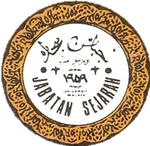Submissions
Submission Preparation Checklist
As part of the submission process, authors are required to check off their submission's compliance with all of the following items, and submissions may be returned to authors that do not adhere to these guidelines.- The submission has not been previously published, nor is it before another journal for consideration (or an explanation has been provided in Comments to the Editor).
- The submission file is in Microsoft Word file format.
- Where available, URLs for the references have been provided.
- The text is single-spaced; uses a 12-point font; employs italics, rather than underlining (except with URL addresses); and all illustrations, figures, and tables are placed within the text at the appropriate points, rather than at the end.
- The text adheres to the Endnote and Reference format outlined in the Author Guidelines.
- For manuscripts not in English (e.g in Malay), the title, abstract and keywords in English are provided. The list of references have been written in Roman alphabet.
Privacy Statement
Peer Review Policies
Sejarah is a journal exercises a double-blind peer review policy with a minimum of two referees per submission. Prospective authors will receive feedback on their submission, with guidelines for revisions if, and where, appropriate.
Sejarah follows a code of best practice familiar to all scholarly journals. This means that the editorial board conducts peer-reviews to ensure the academic integrity and quality of all contributions; continually strives to improve the journal by listening to feedback from authors, editors, readers, and reviewers; provides comprehensive guidance for all authors and reviewers; and places intellectual and ethical standards over business needs.
Selection Criteria
Sejarah is a masked or blind peer-review journal. The general guidelines for the acceptance for publication of a submitted manuscript are as follows:
- Relevance
Papers within the disciplines and areas of archaeology, oral history, regional history, comparative politics, government, gender studies, political studies, regional and international politics, national and international security, human security, foreign policy and diplomacy, international inter and intra-cultural studies, peace and conflict studies, and area studies covering the Asia-Pacific regionsare considered.
- Standard and Criteria
Manuscripts that exhibit most of the following characteristics meet the selection criteria for publication:
- Content: Original manuscript with significant findings that contribute to the discipline of history, politics or international relations that also command a general interest.
- Presentation: Systematic, easily comprehensible and well-organized prose. It is required that the arguments.
- Language: Simple, coherent and highly intelligible to a general intellectual audience. The journal accepts manuscripts written in English, Malay or in Bahasa Indonesia. There should be minimal usage of specialized terms, jargons or technical language. If such specialized terms, jargons or technical language are unavoidable, please insert an explanatory note to follow in parentheses.
- Convention: Conformity to Sejarah-style.
Many manuscripts are not accepted for publication because they are too elementary, poorly written and/or poorly organized, incoherent, too specialized in scope, unduly technical, or excessively long and do not conform to the journal style as mentioned in submission guideline. Such papers that are rejected are promptly returned to the author.
Peer-Review Process
The Managing Editor conducts a preliminary review of all the manuscripts sent to the journal. Manuscripts that are considered entirely inappropriate will be rejected at this stage. Next, the selected manuscripts are allocated to suitable reviewers. All reviews are conducted anonymously, to help ensure the integrity, objectivity, and fairness of the evaluation. The two reviewers will be asked to evaluate the strength of the manuscript based on its theoretical or conceptual framework, methodology, argument, contribution to the field, literature review, prose and style. They will then provide comments for the editor-in-chief, and suggestions for revision for the author where appropriate, within three weeks of receiving the manuscript. Based on their evaluation, reviewers will suggest one of the following:
- That the manuscript be rejected
- That additional reviews are required
- That the author(s) be invited to revise and resubmit the manuscript
- That the manuscript be accepted with minor changes
Reviewer’s comments are forwarded to the author. Where revisions are indicated, constructive suggestions and advice will be provided to the author for revising the manuscript. Manuscripts are rarely accepted without revision.
The decision as to whether or not, or how, to address the reviewers comments are left with the author. If the author decides to submit a revised manuscript, he or she is also expected to provide information describing how they have addressed the reviewer’s comments.
Subsequently, the editors send the revised paper out for review, if necessary. At least one of the original reviewers will be asked to re-examine the article.
When the second review is complete, the editors decide whether the paper is ready to be published; needs another round of revisions; or the paper should be rejected. It should be noted that the final acceptance or rejection entirely rests with the editorial board, who reserve the right to refuse publication on reasonable grounds.
Process after the Acceptance of a Manuscript
After a manuscript has been accepted, it is considered to be ‘in press’. At this stage, the author may be asked to respond to queries from the publisher normally on issues of style, in-text citations, references, tables, clarity, and grammar. Following these minor corrections, proofs are sent to the corresponding authors for their final approval. At this point, only essential changes are accepted.

